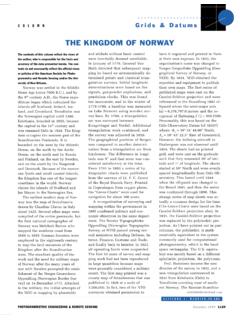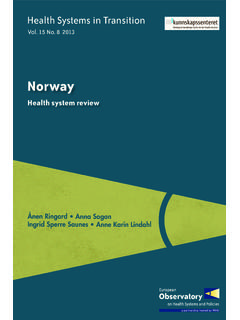Transcription of Employment Outlook 2017 - OECD.org
1 OECD Employment Outlook 2017 OECD 2017 OECD Employment Outlook publication page How does NORWAY compare? Employment Outlook 2017 August 2017 The 2017 edition of the OECD Employment Outlook provides an international assessment of recent labour market trends and short-term prospects. It also contains chapters on: benchmarking labour market performance based on the new OECD Jobs Strategy scoreboard; labour market resilience in the wake of the global crisis; the role of technological change and globalisation in transforming labour markets; and key country differences in collective bargaining arrangements. DOI: Labour market developments in Norway Note: OECD weighted average.
2 Source: OECD calculations based on OECD Economic Outlook Database (No. 101), June LABOUR MARKET TRENDS AND PROSPECTS Labour market conditions continue to improve and the OECD average Employment rate finally returned to its pre-crisis rate in the first quarter of 2017 , nearly ten years after the global financial crisis erupted. The OECD-average unemployment rate continues its slow descent, but remains slightly above its pre-crisis level because Employment has not increased enough to fully offset a rising trend in participation rates. The unemployment rate is projected to fall back to its pre-crisis level in late 2018 or early 2019. The recovery remains very uneven across countries and different groups within the workforce.
3 The unemployment rate increased more slowly in Norway than in most OECD countries in the years following the economic crisis. Norway maintained its unemployment level well below the OECD average, but in late 2014 it started to rise. While unemployment rates fell on average across OECD countries between 2014 and 2016, it increased by percentage point in Norway over the same period. Projections for 2017 and 2018, in contrast, point to a decrease in the Norwegian unemployment rate. The Nordic countries have some of the highest Employment rates across the OECD. In Norway, 67% of the population aged 15 to 74 years-old was employed in last quarter of 2016.
4 However, the rate has been a steadily declining since it peaked at 73% in mid-2008. The high Employment rate is partially explained by the many policies encouraging female Employment , such as good availability of subsidised child-care services and working-time flexibility. Moreover, Norway actively promotes a greater gender balance in the boardroom and since 2006 legally requires that women make up at least 40% of boards of publicly listed companies B. Unemployment rate Percentage of total labour force A. Employment rate Percentage of the population aged 15-74 Projections Projections Contacts: Diogo Amaro de Paula (+33 1 85 55 47 83; or Mark Pearson (+33 1 45 24 92 69; Directorate for Employment , Labour and Social Affairs.))
5 OECD Employment Outlook publication page OECD Employment Outlook 2017 OECD 2017 Scoreboard of labour market performance for Norway Note: An upward (downward ) pointing arrow for an indicator means that higher (lower) values reflect better performance. Earnings quality: Gross hourly earnings in USD adjusted for inequality. Labour market insecurity: Expected monetary loss associated with the risk of becoming unemployed as a share of previous earnings. Job strain: Percentage of workers in jobs characterised by a combination of high job demands and few job resources to meet those demands. Low income rate: Share of working-age persons living with less than 50% of median equivalised household disposable income.
6 Gender labour income gap: Difference between average per capita annual earnings of men and women divided by average per capita earnings of men. Employment gap for disadvantaged groups: Average difference in the Employment rate for prime-age men and the rates for five disadvantaged groups (mothers with children, youth who are not in full-time education or training, workers aged 55-64, non-natives, and persons with disabilities) as a percentage of the Employment rate for prime-age men. Source and definitions: OECD calculations using data for 2015 or latest year available from multiple sources. See OECD Employment Outlook 2017 , Table for further detailsNEW OECD SCOREBOARD SHOWS RELATIVE STRENGTHS AND WEAKNESSES OF NORWAY LABOUR MARKET The 2017 issue of the OECD Employment Outlook presents a comparative scoreboard of labour market performance that provides a rich overview of the strengths and weaknesses of different national labour markets, going well beyond the standard measures of Employment and unemployment rates.
7 These include measures of job quality (pay, Employment security, working environment) and labour market inclusiveness (income equality, gender equality, Employment access for potentially disadvantaged groups). Some countries score well on most or all indicators, implying that there are no hard trade-offs that prevent countries from performing well in all areas. Norway follows the pattern of most Nordic countries, performing better than the OECD average in quantity, quality and inclusiveness dimensions of the labour market. Collective bargaining plays a pivotal role in Norway. Some countries have high union membership because unemployment benefits are administered by union-affiliated institutions.
8 Of those countries which don t run their unemployment insurance in this way, Norway is the only one with a union membership rate above 50%. Norway has the second lowest level of labour market insecurity across OECD countries. Workers who become and stay unemployed are expected to lose a mere of their previous earnings. This is the combined outcome of low unemployment rates and high levels of benefit payments. The inclusiveness of Norway s labour market is above the OECD average, but not by much. Men still earn 35% more than women who are in work, and 9% of the working-age population lives on less than 50% of median equalized household disposable income.
9 Nevertheless, Norway is one of the top performing countries in inclusion of disadvantaged groups, having an average Employment gap compared to prime-age male workers of only 17% versus 25% on average across OECD countries. Employment rate ( ) Full-time equivalent Employment rate ( ) Unemployment rate ( ) Earnings quality ( ) Labour market insecurity ( ) Job strain ( ) Low income rate ( ) Gender labour income gap ( ) Employment gap for disadvantaged groups ( ) Quantity Quality Inclusiveness















